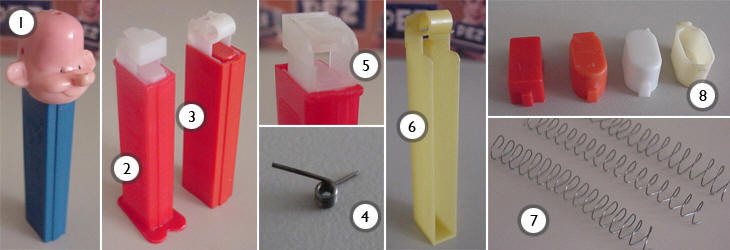Pez Anatomy
![]()
The first thing PEZ collectors should familarize
themselves with are the parts of a dispenser. An understanding of how PEZ are
put together and taken apart will surely come in handy.

1. Head
The character molded head of a dispenser, that locks into the dispenser stem.
The head may or may not have removable accessories. Both licensed and
non-licensed characters have been produced since 1954. Note: Some heads are ONLY
available on specific color stems (beware of
stem switching).
2. Stem (footed)
All dispensers produced with a 4.9 patent number were made using footed stems.
The "feet" on the bottom of this stem help the dispenser stand upright.
3. Stem (non-footed)
Dispensers with these non-footed stems tend to be more valuable, and are
considered "vintage." Note: Some current dispensers, such as the R-series
Trucks, reissue Regulars, and Valentine's Day Hearts are sold on a non-footed
stem with a wider spine than vintage stems.
4. Metal Pin Hinge
Pictured is a small metal pin hinge that provides the "spring-action" of many
vintage dispensers. This piece fits underneath the dispenser head and locks in
to the head-candy pusher.
5. Plastic hinge
In 1963, PEZ began manufacture of this type of hinge. Metal hinges were produced
for a few years later, until the transformation to the plastic hinge was
complete. This hinge also provides the "spring-action" of the head of the
dispenser. Current dispensers feature a multi-level plastic hinge, as pictured.
6. Candy Cartridge
Plastic part of a dispenser that slides up and down inside of the stem. Candy is
loaded into this cartridge. These cartridges vary in color on many vintage
dispensers, but most current dispensers feature a clear translucent white
plastic.
7. Spings
The springs are loaded underneath the candy pusher, which secures its position
inside the grooves of the stem. These springs provide the retractable loading
mechanism as candy is removed from the dispenser.
8. Candy Pusher (stem)
These small pieces vary in shape, color and size depending on the specific
dispenser and year of manufacture. Their function, however, remains the same,
they secure the spring by locking into the grooves molded inside the stem. For
this reason, only certain stems are compatible with certain candy pushers.